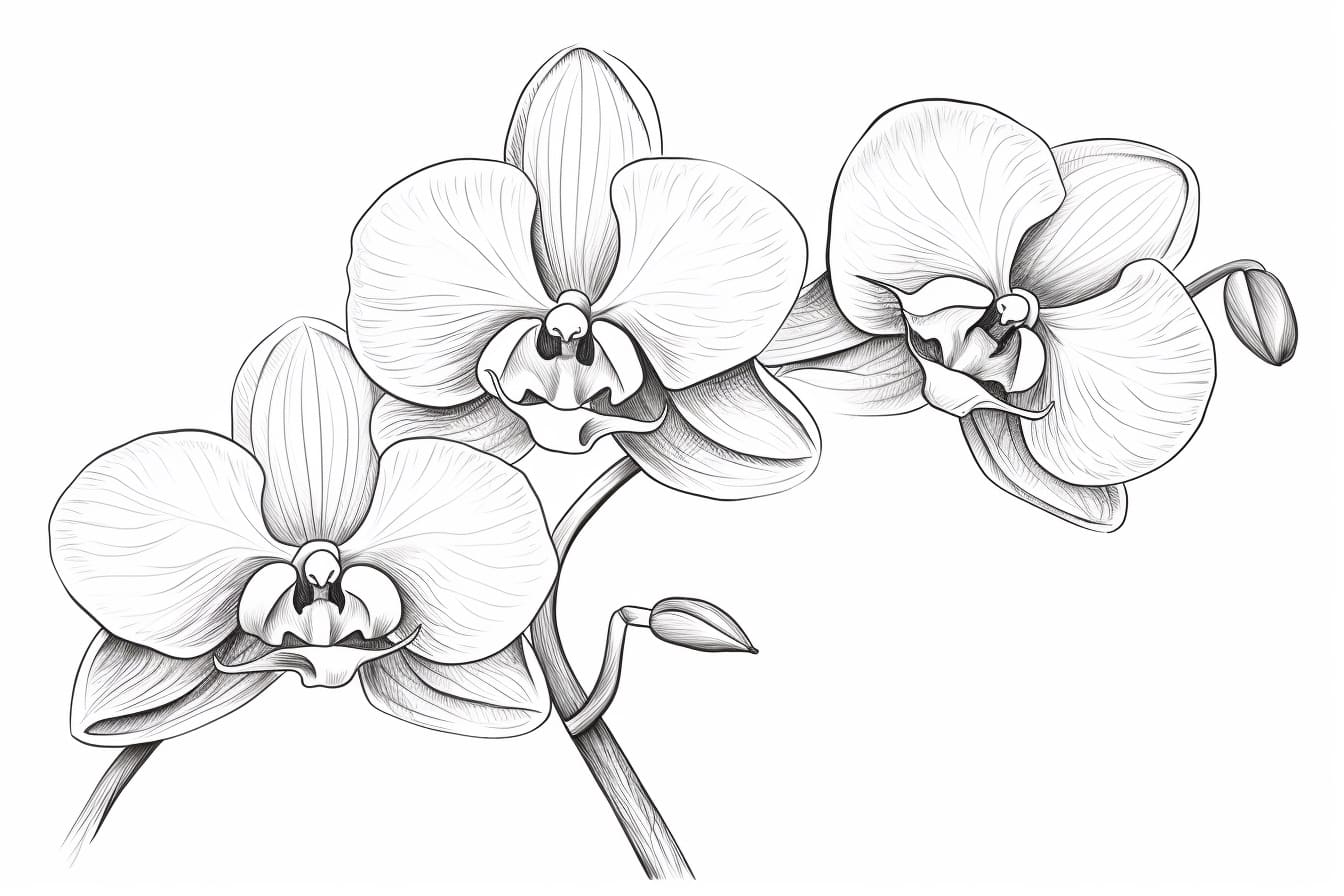Drawing an orchid plant can be a truly rewarding experience, as these exquisite flowers are not only visually stunning but also possess intricate details and delicate features that offer a unique challenge for artists. With their diverse shapes, colors, and textures, orchids provide an endless array of possibilities for creative expression. In this guide, we will explore the art of capturing the beauty and elegance of orchids through drawing, focusing on techniques to depict their graceful forms and intricate patterns. Whether you are a beginner looking to improve your drawing skills or an experienced artist seeking a new subject to explore, drawing orchids is sure to inspire and captivate your artistic senses. Let’s dive into the enchanting world of orchid drawing and unleash your creativity!
Materials Required
To draw an orchid plant, you will need the following materials:
- Pencils: A variety of graphite pencils in different hardness (e.g. 2H, HB, 2B) for sketching and shading.
- Erasers: A kneaded eraser for lightening or removing graphite marks, and a regular eraser for more precise erasing.
- Paper: Choose a smooth, heavyweight paper or sketch pad that can handle shading and blending.
- Drawing board: To provide a sturdy surface for drawing and prevent the paper from buckling.
- Reference image: A photo or real-life orchid plant to use as a visual reference for your drawing.
- Pen or fine liner: Optional for adding
How to Draw an Orchid Plant: a Step-by-step Guide
Step 1: Sketching the Overall Shape
Start by drawing a light oval shape to represent the base of the orchid plant. This will serve as a guide for the overall shape of the plant.
Step 2: Drawing the Stem and Leaves
From the top of the oval shape, draw a long, slender stem extending upwards. Add a series of long, narrow leaves along the stem. Orchid leaves are typically elongated and have a slightly wavy edge.
Step 3: Adding the Flowers
Draw a cluster of orchid flowers at the top of the stem. Orchid flowers have a unique shape with three large petals and three smaller petals. The larger petals often have intricate patterns and details. Take your time to capture the delicate beauty of the orchid flowers.
Step 4: Detailing the Flowers and Leaves
Add details to the flowers such as veins on the petals and a central column (known as the column) in the center of the flower. Pay attention to the intricate patterns and textures that make each orchid unique. For the leaves, you can add veins and subtle shading to give them a more realistic appearance.
Step 5: Refining and Finalizing
Go over your drawing, refining any lines and adding any additional details or shading to enhance the overall look of the orchid plant. Take your time to ensure that all elements of the plant are well-defined and balanced.
Step 6: Erasing Guidelines
Once you are satisfied with your drawing, carefully erase any remaining guidelines or sketch lines to clean up the final image.
Step 7: Adding Color (Optional)
If you choose to add color to your drawing, consider using colored pencils, markers, or watercolors to bring your orchid plant to life. Pay attention to the natural colors of orchids, which can range from white and pink to vibrant purples and yellows.
Step 8: Final Touches
Make any final adjustments or additions to your drawing to complete the artwork. Consider adding a background or additional elements to enhance the composition if desired.
By following these steps and taking your time to observe and replicate the unique characteristics of orchid plants, you can create a beautiful and detailed drawing of an orchid plant.
Conclusion
In conclusion, drawing an orchid plant can be a rewarding and enjoyable artistic endeavor. By following the step-by-step guide outlined in this article, you can capture the delicate beauty and intricate details of an orchid with confidence and skill. Remember to practice patience, observe your subject closely, and embrace the unique characteristics of each flower. With dedication and practice, you can create stunning orchid drawings that showcase your creativity and artistic talent. Keep exploring and experimenting with different techniques to further enhance your drawing abilities and bring your orchid illustrations to life.
Fun Facts About Orchid Plants
- Orchids are one of the largest and most diverse flowering plant families, with over 25,000 species found worldwide.
- Orchids have unique and complex relationships with pollinators, often evolving specific shapes, colors, and scents to attract their particular pollinators.
- Some orchid species have evolved to mimic the appearance and scent of female insects to attract male pollinators, a phenomenon known as sexual deception.
- Orchid seeds are among the smallest in the plant kingdom, and they require a symbiotic relationship with fungi to germinate and grow.
- Vanilla, one of the most popular flavors in the world, is derived from the pods of the Vanilla orchid (Vanilla planifolia).
- Orchids have been cultivated and prized for their beauty for thousands of years, with ancient civilizations such as the Aztecs and Greeks valuing them for their ornamental and medicinal properties.
- Some orchid species have highly specialized growing requirements, such as specific temperature, humidity, and light levels, making them challenging but rewarding plants to cultivate.
- Orchids have been used in traditional medicine for various purposes, including treating ailments such as coughs, fevers, and skin conditions.
- The practice of collecting and cultivating orchids as a hobby, known as orchidophilia, has a long history and continues to be a popular pastime for enthusiasts worldwide.
- Orchids have inspired numerous myths, legends, and cultural symbols throughout history, with some cultures associating them with love, beauty, and luxury.
Suggestions for Scenes and Settings for Orchid Plant Drawings
- Orchid Plant in a Rainforest Setting: Capture the lush greenery and vibrant colors of the rainforest as the orchid blooms amidst a backdrop of towering trees, exotic flowers, and cascading waterfalls.
- Orchid Plant in a Zen Garden: Create a tranquil scene with the orchid placed in a Japanese-style Zen garden surrounded by carefully raked gravel, bonsai trees, and a serene koi pond.
- Orchid Plant in a Botanical Garden Conservatory: Showcase the orchid in a glass conservatory filled with a diverse array of plant species, sunlight streaming in through the windows, and a misty atmosphere enhancing the beauty of the blooms.
- Orchid Plant on a Windowsill: Illustrate the orchid displayed on a sunlit windowsill, with a view of a bustling cityscape or a peaceful countryside outside the window, highlighting the contrast between urban life and nature.
- Orchid Plant in a Victorian Greenhouse: Transport viewers to a bygone era with a drawing of the orchid flourishing in an ornate Victorian greenhouse, complete with intricate ironwork, stained glass windows, and antique decor.
- Orchid Plant in a Magical Fairy Garden: Let your imagination run wild as you depict the orchid as a centerpiece in a whimsical fairy garden, surrounded by tiny fairy houses, enchanted creatures, and sparkling fairy lights.
- Orchid Plant in a Lunar Landscape: Take a futuristic approach by drawing the orchid in a lunar landscape, with a backdrop of a barren moon surface, distant planets, and a star-filled sky, highlighting the delicate beauty of the flower against a harsh environment.
- Orchid Plant in a Tropical Paradise: Picture the orchid blooming in a tropical paradise with palm trees swaying in the breeze, crystal-clear turquoise waters lapping at the shore, and colorful birds flying overhead, evoking a sense of relaxation and escape.
- Orchid Plant in a Surreal Dreamland: Challenge conventional boundaries by placing the orchid in a surreal dreamland filled with floating islands, oversized flowers, and fantastical creatures, inviting viewers to explore a world of imagination and fantasy.
- Orchid Plant in a Celestial Observatory: Combine the beauty of the orchid with the wonders of the universe by drawing it in a celestial observatory, surrounded by telescopes, constellations, and cosmic phenomena, symbolizing the harmony between nature and the cosmos.









